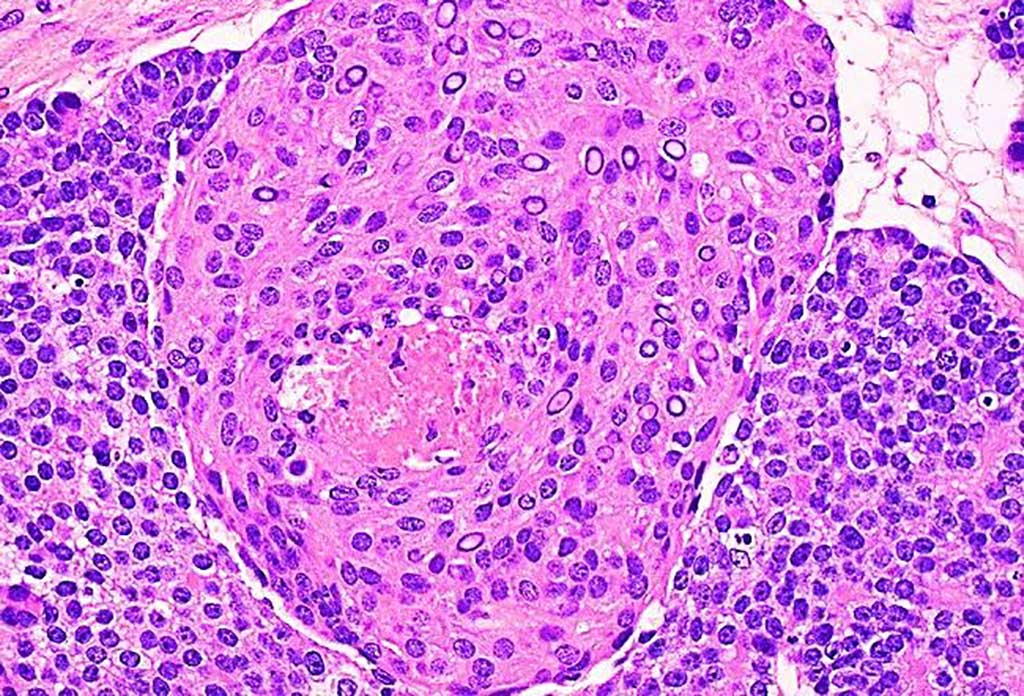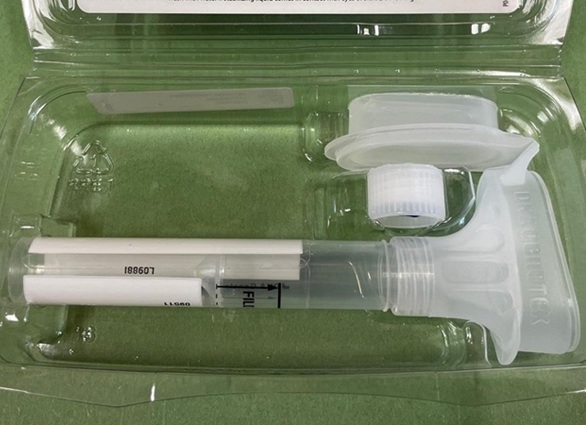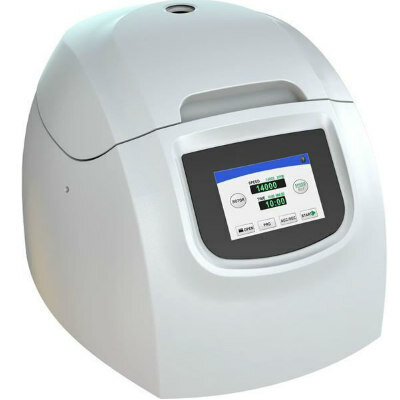Pediatric Pancreatic Cancer Diagnosed from cfDNA Fragments in Urine
|
By LabMedica International staff writers Posted on 17 Mar 2021 |

Image: Histopathology of pancreatoblastoma showing a large squamoid nest surrounded by sheet of bland monomorphic cells. Many of the squamous cell nuclei are optically clear due to accumulation of biotin (Photo courtesy of Dharam Ramnani, MD).
Although rare, pancreatoblastoma is the most common pancreatic tumor of young children. Carcinoma of acinar cell origin has rarely been reported in older children. Ductal adenocarcinoma and its many variants are the most common pancreatic tumors in adults, but these are exceedingly rare in children.
Cell-free DNA (cfDNA) in urine is a promising analyte for noninvasive diagnostics. However, urine cfDNA is highly fragmented. Whether characteristics of these fragments reflect underlying genomic architecture is unknown. Compared to cfDNA from healthy individuals, tumor-derived fragmentation patterns ending within recurrently protected regions occurred more frequently in urine.
A team of scientists at the Translational Genomics Research Institute (Phoenix, AZ, USA) and their medical colleagues used whole-genome sequencing (WGS) on 30 urine and 15 plasma samples from healthy patients to determine cfDNA fragment size distribution. The group also evaluated urine samples from eight healthy and 22 stages I-IV cancer patients (10 pediatric and 12 pancreatic cancer).
The team reported that size distribution of urine cfDNA fragments showed multiple strong peaks between 40 and 120 base pairs (bp) with a modal size of 81- and sharp 10-bp periodicity, suggesting transient protection from complete degradation. These properties were robust to pre-analytical perturbations, such as at-home collection and delay in processing. Genome-wide sequencing coverage of urine cfDNA fragments revealed recurrently protected regions (RPRs) conserved across individuals, with partial overlap with nucleosome positioning maps inferred from plasma cfDNA. The ends of cfDNA fragments clustered upstream and downstream of RPRs, and nucleotide frequencies of fragment ends indicated enzymatic digestion of urine cfDNA. Compared to plasma, fragmentation patterns in urine cfDNA showed greater correlation with gene expression and chromatin accessibility in epithelial cells of the urinary tract.
To ensure the elevations in fragment-based RPRs were linked to the patients' tumor and not from other physiological responses, the team compared fraction of aberrant fragments (FAFs) in genomic regions with copy number gains and losses in tumor DNA. They saw that the FAFs in urine increased in regions where the patients' tumor DNA carried a copy number gain, even though the copy number changes were below the limit of detection in urine circulating tumor DNA (ctDNA). The team determined that tumor-derived urine cfDNA exhibits a higher FAFs that end within RPRs. By comparing the fraction of aberrant fragments and nucleotide frequencies of fragment ends, they identified urine samples from cancer patients with an area under the curve of 0.89.
Muhammad Murtaza, MBBS, PhD, an associate professor and a senior author of the study, said, “When you look at plasma, on average, you find that the fragment size in closed chromatin regions are slightly longer than the fragment size in open chromatin regions. We found a similar trend for fragment size in urine samples.”
The authors concluded that their results revealed nonrandom genomic positioning of urine cfDNA fragments and suggested that analysis of fragmentation patterns across recurrently protected genomic loci may serve as a cancer diagnostic. The study was published on February 17, 2021 in the journal Science Translational Medicine.
Related Links:
Translational Genomics Research Institute
Cell-free DNA (cfDNA) in urine is a promising analyte for noninvasive diagnostics. However, urine cfDNA is highly fragmented. Whether characteristics of these fragments reflect underlying genomic architecture is unknown. Compared to cfDNA from healthy individuals, tumor-derived fragmentation patterns ending within recurrently protected regions occurred more frequently in urine.
A team of scientists at the Translational Genomics Research Institute (Phoenix, AZ, USA) and their medical colleagues used whole-genome sequencing (WGS) on 30 urine and 15 plasma samples from healthy patients to determine cfDNA fragment size distribution. The group also evaluated urine samples from eight healthy and 22 stages I-IV cancer patients (10 pediatric and 12 pancreatic cancer).
The team reported that size distribution of urine cfDNA fragments showed multiple strong peaks between 40 and 120 base pairs (bp) with a modal size of 81- and sharp 10-bp periodicity, suggesting transient protection from complete degradation. These properties were robust to pre-analytical perturbations, such as at-home collection and delay in processing. Genome-wide sequencing coverage of urine cfDNA fragments revealed recurrently protected regions (RPRs) conserved across individuals, with partial overlap with nucleosome positioning maps inferred from plasma cfDNA. The ends of cfDNA fragments clustered upstream and downstream of RPRs, and nucleotide frequencies of fragment ends indicated enzymatic digestion of urine cfDNA. Compared to plasma, fragmentation patterns in urine cfDNA showed greater correlation with gene expression and chromatin accessibility in epithelial cells of the urinary tract.
To ensure the elevations in fragment-based RPRs were linked to the patients' tumor and not from other physiological responses, the team compared fraction of aberrant fragments (FAFs) in genomic regions with copy number gains and losses in tumor DNA. They saw that the FAFs in urine increased in regions where the patients' tumor DNA carried a copy number gain, even though the copy number changes were below the limit of detection in urine circulating tumor DNA (ctDNA). The team determined that tumor-derived urine cfDNA exhibits a higher FAFs that end within RPRs. By comparing the fraction of aberrant fragments and nucleotide frequencies of fragment ends, they identified urine samples from cancer patients with an area under the curve of 0.89.
Muhammad Murtaza, MBBS, PhD, an associate professor and a senior author of the study, said, “When you look at plasma, on average, you find that the fragment size in closed chromatin regions are slightly longer than the fragment size in open chromatin regions. We found a similar trend for fragment size in urine samples.”
The authors concluded that their results revealed nonrandom genomic positioning of urine cfDNA fragments and suggested that analysis of fragmentation patterns across recurrently protected genomic loci may serve as a cancer diagnostic. The study was published on February 17, 2021 in the journal Science Translational Medicine.
Related Links:
Translational Genomics Research Institute
Latest Pathology News
- Spit Test More Accurate at Identifying Future Prostate Cancer Risk
- DNA Nanotechnology Boosts Sensitivity of Test Strips
- Novel UV and Machine Learning-Aided Method Detects Microbial Contamination in Cell Cultures
- New Error-Corrected Method to Help Detect Cancer from Blood Samples Alone
- "Metal Detector" Algorithm Hunts Down Vulnerable Tumors
- Novel Technique Uses ‘Sugar’ Signatures to Identify and Classify Pancreatic Cancer Cell Subtypes
- Advanced Imaging Reveals Mechanisms Causing Autoimmune Disease
- AI Model Effectively Predicts Patient Outcomes in Common Lung Cancer Type
- AI Model Predicts Patient Response to Bladder Cancer Treatment
- New Laser-Based Method to Accelerate Cancer Diagnosis
- New AI Model Predicts Gene Variants’ Effects on Specific Diseases
- Powerful AI Tool Diagnoses Coeliac Disease from Biopsy Images with Over 97% Accuracy
- Pre-Analytical Conditions Influence Cell-Free MicroRNA Stability in Blood Plasma Samples
- 3D Cell Culture System Could Revolutionize Cancer Diagnostics
- Painless Technique Measures Glucose Concentrations in Solution and Tissue Via Sound Waves
- Skin-Based Test to Improve Diagnosis of Rare, Debilitating Neurodegenerative Disease
Channels
Clinical Chemistry
view channel
‘Brilliantly Luminous’ Nanoscale Chemical Tool to Improve Disease Detection
Thousands of commercially available glowing molecules known as fluorophores are commonly used in medical imaging, disease detection, biomarker tagging, and chemical analysis. They are also integral in... Read more
Low-Cost Portable Screening Test to Transform Kidney Disease Detection
Millions of individuals suffer from kidney disease, which often remains undiagnosed until it has reached a critical stage. This silent epidemic not only diminishes the quality of life for those affected... Read more
New Method Uses Pulsed Infrared Light to Find Cancer's 'Fingerprints' In Blood Plasma
Cancer diagnoses have traditionally relied on invasive or time-consuming procedures like tissue biopsies. Now, new research published in ACS Central Science introduces a method that utilizes pulsed infrared... Read moreHematology
view channel
New Scoring System Predicts Risk of Developing Cancer from Common Blood Disorder
Clonal cytopenia of undetermined significance (CCUS) is a blood disorder commonly found in older adults, characterized by mutations in blood cells and a low blood count, but without any obvious cause or... Read more
Non-Invasive Prenatal Test for Fetal RhD Status Demonstrates 100% Accuracy
In the United States, approximately 15% of pregnant individuals are RhD-negative. However, in about 40% of these cases, the fetus is also RhD-negative, making the administration of RhoGAM unnecessary.... Read moreImmunology
view channel
Stem Cell Test Predicts Treatment Outcome for Patients with Platinum-Resistant Ovarian Cancer
Epithelial ovarian cancer frequently responds to chemotherapy initially, but eventually, the tumor develops resistance to the therapy, leading to regrowth. This resistance is partially due to the activation... Read more
Machine Learning-Enabled Blood Test Predicts Immunotherapy Response in Lymphoma Patients
Chimeric antigen receptor (CAR) T-cell therapy has emerged as one of the most promising recent developments in the treatment of blood cancers. However, over half of non-Hodgkin lymphoma (NHL) patients... Read moreMicrobiology
view channel
Handheld Device Delivers Low-Cost TB Results in Less Than One Hour
Tuberculosis (TB) remains the deadliest infectious disease globally, affecting an estimated 10 million people annually. In 2021, about 4.2 million TB cases went undiagnosed or unreported, mainly due to... Read more
New AI-Based Method Improves Diagnosis of Drug-Resistant Infections
Drug-resistant infections, particularly those caused by deadly bacteria like tuberculosis and staphylococcus, are rapidly emerging as a global health emergency. These infections are more difficult to treat,... Read more
Breakthrough Diagnostic Technology Identifies Bacterial Infections with Almost 100% Accuracy within Three Hours
Rapid and precise identification of pathogenic microbes in patient samples is essential for the effective treatment of acute infectious diseases, such as sepsis. The fluorescence in situ hybridization... Read morePathology
view channel
Spit Test More Accurate at Identifying Future Prostate Cancer Risk
Currently, blood tests that measure the level of a protein called prostate-specific antigen (PSA) are commonly used to identify men at higher risk for prostate cancer. This test is typically used based... Read moreDNA Nanotechnology Boosts Sensitivity of Test Strips
Since the Covid-19 pandemic, most people have become familiar with paper-based rapid test strips, also known as lateral flow immunoassays (LFIAs). These tests are used to quickly detect biomarkers that... Read more
Novel UV and Machine Learning-Aided Method Detects Microbial Contamination in Cell Cultures
Cell therapy holds great potential in treating diseases such as cancers, inflammatory conditions, and chronic degenerative disorders by manipulating or replacing cells to restore function or combat disease.... Read moreTechnology
view channel
Disposable Microchip Technology Could Selectively Detect HIV in Whole Blood Samples
As of the end of 2023, approximately 40 million people globally were living with HIV, and around 630,000 individuals died from AIDS-related illnesses that same year. Despite a substantial decline in deaths... Read more
Pain-On-A-Chip Microfluidic Device Determines Types of Chronic Pain from Blood Samples
Chronic pain is a widespread condition that remains difficult to manage, and existing clinical methods for its treatment rely largely on self-reporting, which can be subjective and especially problematic... Read more
Innovative, Label-Free Ratiometric Fluorosensor Enables More Sensitive Viral RNA Detection
Viruses present a major global health risk, as demonstrated by recent pandemics, making early detection and identification essential for preventing new outbreaks. While traditional detection methods are... Read moreIndustry
view channel
Cepheid and Oxford Nanopore Technologies Partner on Advancing Automated Sequencing-Based Solutions
Cepheid (Sunnyvale, CA, USA), a leading molecular diagnostics company, and Oxford Nanopore Technologies (Oxford, UK), the company behind a new generation of sequencing-based molecular analysis technologies,... Read more
Grifols and Tecan’s IBL Collaborate on Advanced Biomarker Panels
Grifols (Barcelona, Spain), one of the world’s leading producers of plasma-derived medicines and innovative diagnostic solutions, is expanding its offer in clinical diagnostics through a strategic partnership... Read more




















